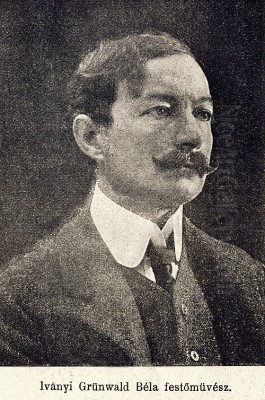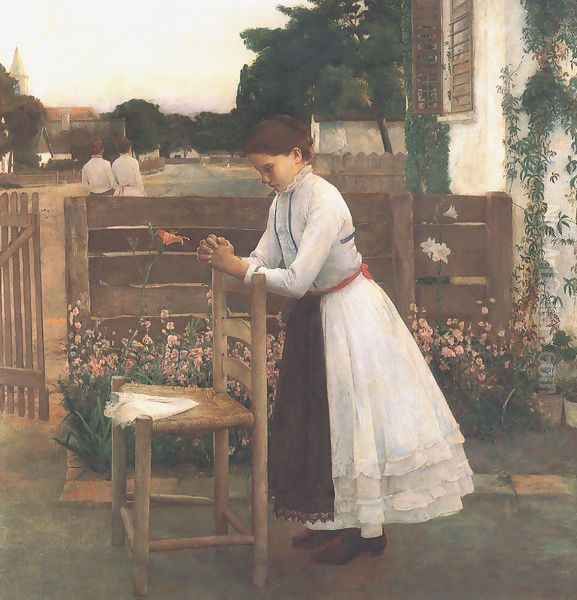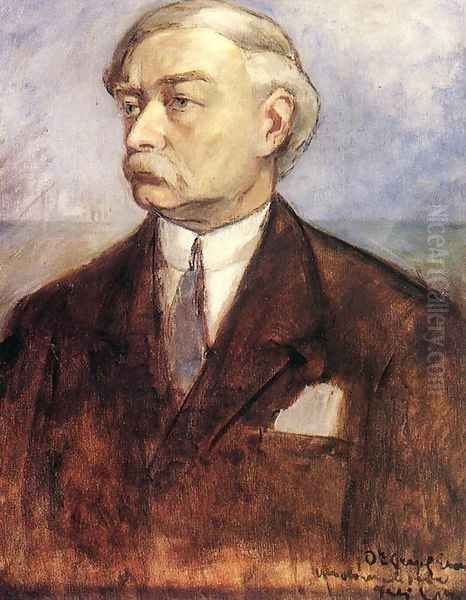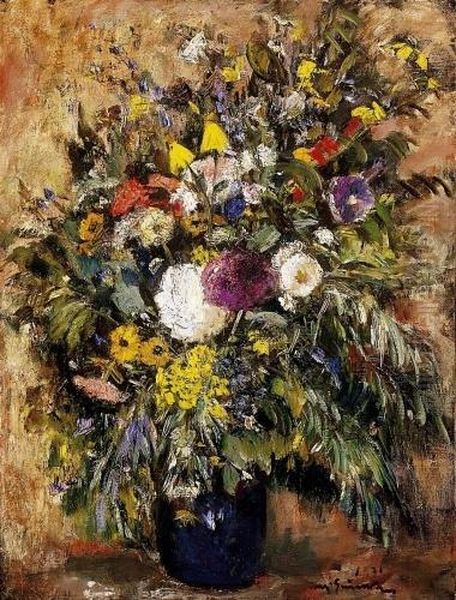
Béla Iványi-Grünwald stands as a significant and transformative figure in the landscape of Hungarian art history. Born on May 6, 1867, in the village of Som, Somogy County, Hungary, and passing away on September 24, 1940, in Budapest, his life spanned a period of immense artistic change in Europe. Iványi-Grünwald was not merely a painter but a central organizer and leading member of the influential Nagybánya artists' colony and later the founder of the Kecskemét artists' colony. His career charts a fascinating course from academic naturalism through plein-air painting to embracing modern, colourful, and decorative styles, making him a key link between 19th-century traditions and 20th-century Hungarian modernism.
His contributions extend beyond his own canvases; he played a crucial role in shaping the direction of Hungarian art, fostering new talent, and introducing progressive European artistic ideas to his homeland. His journey reflects the broader artistic quest of his time: the search for national identity in art combined with an engagement with international trends.
Early Life and Artistic Formation
Iványi-Grünwald's formal artistic education began in Budapest at the Academy of Fine Arts (Mintarajztanoda és Rajztanárképezde) from 1882 to 1886. Here, he studied under prominent figures of Hungarian academic painting, including Bertalan Székely and Károly Lotz. These teachers provided him with a solid foundation in drawing, composition, and the prevailing historical and realistic styles of the era.
Seeking broader horizons, he moved to Munich in 1886-1887, a major art centre at the time, though less progressive than Paris. Following this, he spent crucial years in Paris, from 1887 to 1890, studying at the renowned Académie Julian. This period was pivotal. Paris exposed him to newer currents, particularly the naturalism of artists like Jules Bastien-Lepage and Pascal Dagnan-Bouveret, whose influence is evident in Iványi-Grünwald's early works focusing on rural life and atmospheric detail.

His early output included academic exercises and genre scenes. An early success was Jairus' Daughter (1890). Works like Ave Maria (1891) clearly show the impact of Bastien-Lepage's sentimental naturalism, depicting peasant life with sincerity and careful observation. He demonstrated his skill in large-scale composition with Drawing Lots by the Nihilists (Nihilisták sorsot húznak, 1893), a painting noted for its dramatic use of light and shadow and its engagement with a contemporary, albeit somewhat sensationalized, theme. This work garnered significant attention and marked him as a talent capable of tackling ambitious subjects.
In 1894, Iványi-Grünwald travelled to Egypt with fellow painter Ferenc Eisenhut. This journey resulted in several works with Orientalist themes, reflecting a common interest among European artists of the period in exotic locales, though this remained a relatively minor phase in his overall career compared to his deep engagement with Hungarian landscapes and themes.
The Nagybánya Revolution
A defining moment in Iványi-Grünwald's career and in Hungarian art history was his involvement with the Nagybánya artists' colony. Established in 1896 in Nagybánya (now Baia Mare, Romania), the colony was founded by Simon Hollósy, István Réti, János Thorma, Károly Ferenczy, and Iványi-Grünwald himself. These artists were united by a dissatisfaction with the conservative, studio-bound academicism prevalent in Budapest and Munich.
Inspired by the French Barbizon School and the principles of plein-air (open-air) painting, the Nagybánya artists sought a direct, unmediated engagement with nature. They emphasized the importance of capturing natural light, atmosphere, and local colour. Nagybánya quickly became the most important centre for modern art in Hungary, attracting numerous young artists eager to break from tradition.
Iványi-Grünwald was a leading figure and teacher at Nagybánya during its first decade. His style during this period evolved towards a brighter palette and looser brushwork, characteristic of the colony's approach. He produced numerous landscapes and scenes of rural life set in the picturesque surroundings of Nagybánya.
Key works from this period include Watering (Itatás, 1902), Spring (Tavasz, 1903), and In the Mountains (Hegyek között, 1901). These paintings exemplify the Nagybánya style: a commitment to realism and naturalism, but rendered with a fresh sensitivity to light and colour, often depicting peasants and animals integrated harmoniously into the landscape. His work from this time is considered central to the first phase of modern Hungarian painting.

The Nagybánya colony's influence was profound. It introduced Impressionistic and Post-Impressionistic tendencies into Hungarian art and fostered a generation of artists who would further push the boundaries of modernism. The colony held regular exhibitions in Budapest, challenging the established art institutions and gradually shifting artistic tastes.
Transition and the Influence of Paris: The "Neos"
Around 1906, Iványi-Grünwald's style underwent another significant transformation. A return visit to Paris exposed him more fully to the radical developments in French art, particularly the bold colours and decorative compositions of Post-Impressionism and Fauvism. The 1907 retrospective exhibition of Paul Gauguin in Paris is often cited as a major catalyst for this shift.
Inspired by these new artistic languages, Iványi-Grünwald began to experiment with non-naturalistic colours, flattened perspectives, strong outlines, and a more decorative, stylized approach to form. His work became bolder, more expressive, and less concerned with literal representation. This phase aligns him with the group sometimes referred to as the Hungarian Fauves or the "Neos" (referring to Neo-Impressionism, though Fauvism is a more accurate descriptor for the colour aspect).
This group included younger artists, some associated with Nagybánya, who embraced the avant-garde trends from Paris, such as Béla Czóbel, Vilmos Perlrott-Csaba, Sándor Ziffer, and later figures associated with The Eight group like Róbert Berény and Lajos Tihanyi. Iványi-Grünwald, though older, became a leading proponent of this new direction.
His painting Valley of Nagybánya in the Winter (Nagybányai völgy télen, 1906-1907) already shows signs of this change with its simplified forms and heightened colour contrasts. The culmination of this phase is arguably found in works from around 1909, such as the vibrant and decorative Papagáj (Parrot, sometimes translated as Song of the Wild) and its companion piece Papagájos csendélet (Still life with Parrot). These works, with their brilliant, arbitrary colours and rhythmic compositions, clearly reflect the influence of Gauguin and Matisse.
A Self-Portrait from around 1907 also captures this period of intense artistic exploration and personal reflection, reportedly painted during a time when his wife was ill, adding an emotional depth to the stylistic experimentation. His embrace of modernism was recognized when his works in this new style won a major prize at the National Salon in Budapest in 1909.
Founding the Kecskemét Colony

The recognition and prize money Iványi-Grünwald received in 1909 provided the impetus for his next major organizational venture. Feeling perhaps that Nagybánya was becoming too established or seeking a new environment, he spearheaded the founding of a new artists' colony in Kecskemét, a town on the Great Hungarian Plain (Alföld).
With municipal support, the Kecskemét colony was established in 1909-1911, with Iványi-Grünwald as its leader. It aimed to provide workshops and a supportive environment for artists, particularly those working in a modern spirit. Initially, the colony attracted many artists associated with the "Neo" style, continuing the exploration of colour and decorative form.
The Kecskemét period saw Iványi-Grünwald continue to produce landscapes inspired by the distinctive flat, sun-drenched scenery of the Alföld, quite different from the mountainous region of Nagybánya. His style during the early Kecskemét years often retained the bright palette and decorative tendencies of his "Neo" phase. He remained a guiding figure for the younger artists who gathered there.
The colony played a significant role in decentralizing Hungarian art life, offering an alternative centre to Budapest and Nagybánya. It fostered various artistic activities, including applied arts, reflecting the broader trends of the era, such as the Wiener Werkstätte or the Arts and Crafts movement, although painting remained central.
Later Career and Style
In the years following World War I and leading up to his death in 1940, Iványi-Grünwald's style shifted once again. While he never fully returned to his early academic naturalism, the radical colourism and decorative flatness of his "Neo" phase gradually subsided. His later works often exhibit a more restrained palette and a renewed interest in realistic representation, though informed by his decades of experience with light and colour.
Some critics detect a return to certain aspects of the Nagybánya plein-air tradition, while others note influences from Baroque painting in the richness of tone and composition in some of his later landscapes and figural works. He continued to paint landscapes, particularly scenes from the Lake Balaton region where he spent summers, as well as portraits and still lifes.
Works from this later period might lack the revolutionary charge of his Nagybánya or "Neo" phases, but they demonstrate a mature synthesis of his artistic journey. He remained a respected figure in the Hungarian art world until his death in Budapest in 1940.
Legacy and Significance
Béla Iványi-Grünwald's importance in Hungarian art history is multifaceted. He was a highly skilled painter whose work evolved significantly over his long career, reflecting and contributing to major shifts in European art from the late 19th to the mid-20th century. His journey from academicism through plein-air naturalism to Post-Impressionist and Fauvist-inspired modernism is exemplary of the artistic transformations of his era.
He was a crucial organizer and leader, playing a founding role in the Nagybánya colony, the cradle of modern Hungarian painting, and establishing the Kecskemét colony, another significant artistic centre. Through these institutions, he mentored and influenced generations of Hungarian artists.
His ability to absorb and adapt international trends while remaining rooted in Hungarian subjects and landscapes made his work particularly influential. He helped navigate the path for Hungarian art between national traditions and cosmopolitan modernism. Alongside contemporaries like Károly Ferenczy, József Rippl-Rónai, and the unique visionary Tivadar Csontváry Kosztka, Iványi-Grünwald shaped the course of Hungarian painting at a critical juncture.
His legacy lies not only in his diverse body of work, which is held in major Hungarian museums, including the Hungarian National Gallery, but also in his enduring impact as a catalyst for change and a central figure in the communities that defined modern Hungarian art. He remains a testament to artistic evolution and the vital role of artists in shaping cultural identity.
Conclusion
Béla Iványi-Grünwald was more than just a painter; he was an architect of artistic change in Hungary. His life's work traces a dynamic path through the major artistic movements of his time, leaving behind a rich legacy of paintings that capture the landscapes and spirit of his homeland. As a founder and leader of both the Nagybánya and Kecskemét colonies, his influence extended far beyond his own studio, helping to define the trajectory of modern Hungarian art for decades to come. His journey from the academic halls of Budapest to the avant-garde circles of Paris and back to the heart of the Hungarian landscape solidifies his position as a pivotal and enduring figure in art history.